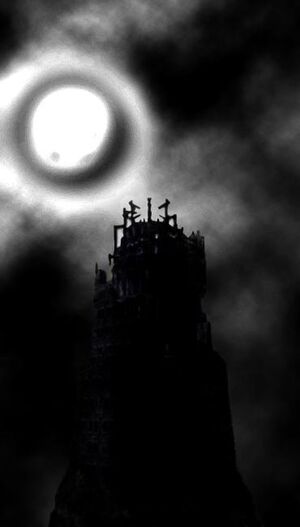
The Temen-ni-gru
The page Temen-ni-gru contains mature content that may include coarse language, sexual references, and/or graphic violent images which may be disturbing to some. Mature pages are recommended for those who are 18 years of age and older.
If you are 18 years or older or are comfortable with graphic material, you are free to view this page. Otherwise, you should close this page and view another page. |
The Temen-ni-gru (sometimes spelled Temen-Ni-Gru) is an ancient tower that serves as the main setting of Devil May Cry 3.
History
The Temen-ni-gru was a towering temple constructed by devil worshippers under the command of their demonic instructors.
It was built as a passage way between the human world and the demon world. People under the influence of devils or praised evil would climb this tower and embraced the powers of darkness.
Originally sealed by Sparda deep underground about 2,000 years ago when he sealed another gate between the two worlds, in a complex ritual requiring him to confiscate the names of the fallen angels representing the seven deadly sins, imprison the tower's five gatekeepers, seal away Leviathan as well as his own demonic power on the other side, split the Perfect Amulet that allows passage between the worlds. Sparda, in the depths of the tower itself, let flow his own blood and that of a mortal priestess with a pure heart, sealing the tower and his own accursed power for all eternity.
The tower thus sunk deep into the earth and time stopped for the world of demons.
Devil May Cry 3
2000 years later, a scholar named Arkham explains to Vergil that resurrecting the tower is the way to obtain his father's ultimate power, so they begin to undo the seals Sparda placed on the tower. Vergil first renames the fallen angels, and then sends Arkham, along with some demons, to persuade Dante to come to the tower so that he can complete the Amulet. Soon after, they raise the tower that has finally rematerialized and began the rituals to power it up to open the portal to the netherworld.
Arkham's daughter, Lady, is also enticed to enter the tower, but Arkham keeps her importance as a descendant of the same priestess, a secret from Vergil, who works on undoing Sparda's spell in the "Lair of Judgment", a sacrificial chamber at the bottom of the tower.
Meanwhile, the mysterious demon Jester leads Dante to Vergil, with Dante slaying all the gatekeepers in his way.
Vergil places the completed Amulet in the control panel and begins bloodletting himself, but is unsuccessful in undoing the final seal. When Dante intrudes upon him, he attacks Dante in the hope that more of "Sparda's blood" will solve the problem, but nothing happens until Lady joins the fight and Arkham arrives. He reveals his identity as Jester, and that the final key to the seal is Mary's blood. After undoing the seal, he stalls the three fighters, taunting them for falling right into his trap, until the Tower activates and they fall off the central platform.
As the platform rises through the tower, collecting huge, demonic bells representing the seven sins, the others race to the top to stop Arkham. However, he reaches the peak of the tower and calls upon the sins in a chant which unseals the final door to the Demon World. As the demonic bells ring and Blood-goyles flock around him, Arkham rises into the Demon World and takes the Force Edge, assuming Sparda's form and power.
After Arkham was killed by Lady while Vergil was defeated and left behind, both her and Dante exit the tower.
The Temen-ni-gru may have dissolved or crushed soon after that. What happened to it was unknown, but one thing for certain: the Temem-ni-gru would never be used to reopen the portal to the Demon World ever again.
Trivia
- The Temen-ni-gru's design draws heavily from the mythological Tower of Babel, especially the painting of it made by Pieter Bruegel the Elder. While the Tower of Babel was built to invade Heaven, the Temen-ni-gru was built as a gateway to Hell.
- The Temen-ni-gru's name may be a reference to the Neo-Sumerian Great Ziggurat of Ur, named "E-temen-nigur(u)" (lit. "house whose foundation creates terror") in Sumerian. It was a structure built to serve as both an administrative center of the city, and as a shrine to Ur's patron diety, the moon god known as Nanna, or Sin. Temen-ni-gru's use to worship sin as immorality is a pun on this.
- The seven demonic bell statues left throughout the tower are a reference to the seven deadly sins.

